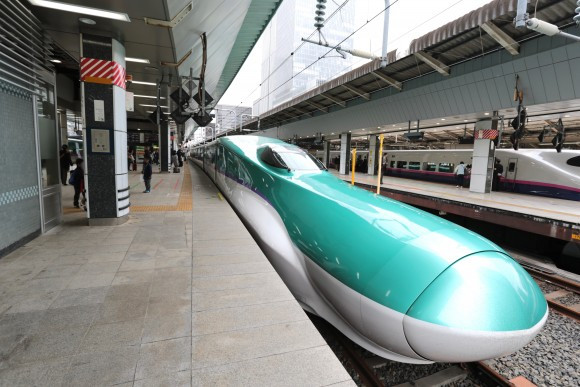
Just how far can you go before you run out of Shinkansen?
Thanks to a new extension, Japan’s Shinkansen train network now stretches all the way from the northern island of Hokkaido to Kagoshima, the southern tip of Kyushu, the southernmost of the country’s four main islands. So to take advantage of this new range of bullet train mobility, we decided to ride the high-speed rails all the way from one end to the other.
Our journey began at 6:35 in the morning, when we stepped from the platform of Shin Hakodate Hokuto Station into a car of the Hayabusa super-express.
Because of the early hour, there was only one other passenger sitting in the same carriage as us. Having the place almost entirely to ourselves made the ordinarily roomy Shinkansen seem all the more spacious.
One of the nicest things about the bullet train are the plentiful electrical outlets, meaning you can easily charge up your phone, camera battery, or laptop.
▼ Our mobile office is all set up.
Since Shin Hakodate Hokuto is the only Shinkansen station on Hokkaido, before very long we passed through the underwater Senkan Tunnel, coming out on Japan’s main island of Honshu where the train made its first stop at Okutsugaru Imabetsu in Aomori Prefecture at 7:25.
Hardly anyone got on here either, but 16 minutes later the train pulled into Shin Aomori Station, where the train finally started to really fill up with passengers.
Since we got on the train at 6:35, we hadn’t had time to eat breakfast, but part of the fun of riding the Shinkansen is the food sold by vendors who walk up and down the aisle. So at eight o’clock, we got ourselves a 1,000-yen (US$9.35) bento boxed lunch.
Many of the Shinkansen bento make use of regional specialties from the regions the train passes through, and our boxed lunch was filled with the seafood that Hokkaido is famous for, with salmon, crab, scallops, and salmon and herring roe all part of the mix.
We also got a box of donut sticks for 800 yen, because you can’t expect us to have breakfast without dessert, can you?
At 9:29, the train made a brief stop in Sendai, the capital of Miyagi Prefecture…
…and at 11:04, we were in the capital of Japan itself, Tokyo.
While the Shinkansen network goes all the way from Hokkaido to Kyushu, there isn’t any single train that makes the complete run. With Tokyo being the last stop for the Hayabusa, we said goodbye to one Shinkansen and hello to another, as we hopped on a Nozomi super-express bound for Osaka, which got underway at 11:23.
One of the shortest gaps between Shinkansen-serviced stations is the Tokyo to Shin Yokohama stretch, and we were at the latter at 11:41, less than 20 minutes after departing Tokyo Station.
At 12:30, our stomachs were starting to growl, so it was time for another 1,000-yen bento!
This time, we went with something a little heartier, choosing a boxed lunch with miso pork cutlet, fried shrimp, anago (saltwater eel), and yuba (tofu skin).
The first of those mouth-watering items is a favorite of the people of Nagoya, while Kyoto is known for the last, and we went through both cities while riding the Nozomi.
▼ The train reached Nagoya at 1:02 in the afternoon…
▼ …and Kyoto at 1:38.
And for dessert number two, ningyoyaki cakes, Tokyo’s representative traditional sweets, in the shape of little bullet trains.
▼ 650 yen gets you a pack of seven.
The last stop for our train was Shin Osaka Station, so 1:53 we transferred again this time to the enchantingly named Sakura super-express, which left six minutes later.
After just about two hours, at 3:57 we arrived at Shin Yamaguchi Station, the final stop on Honshu.
At 4:17, we came to Kokura, the first Sakura station on Kyushu…
…followed by Kyushu’s largest station, Hakata, (which serves the city of Fukuoka) at 4:34.
Rapidly nearing the end of our trip, at five o’clock we got ourselves a dinner bento, which, once again, cost us 1,000 yen.
This one included grilled salmon, fried asparagus cheese rolls, Kasgoshima kuro buta pork, and ebi meshi, a rice and shrimp dish from Okayama Prefecture. The whole thing was filling enough that we were able to show some admirable willpower in not getting a third dessert for the day.
As we happily digested our meal, the train reached Kumamoto at 5:14…
…and at 6:01, the Sakura slowed to a stop, the doors whooshed open, and we were finally at Kagoshima Chuo, as far south as you can go by Shinkansen.
Our total travel time was 11 hours and 26 minutes, and the collection of tickets involved cost us 48,220 yen. Making the trip from Hokkaido to Kyushu by plane is both faster and cheaper, but if you’re a rail fan, the end-to-end Shinkansen route is a memorable way to see the country from ground-level, and the bento really are far tastier than airplane food.
Images ©RocketNews24
[ Read in Japanese ]